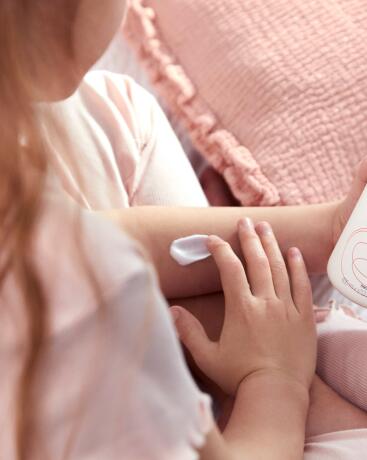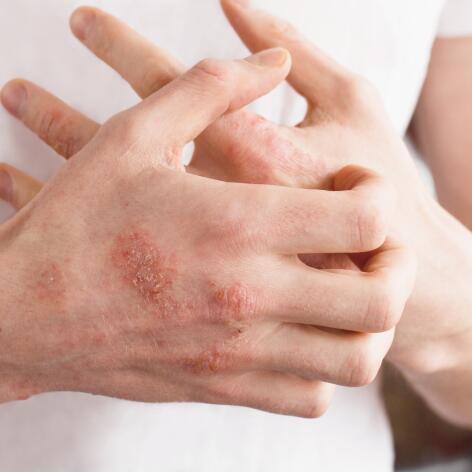The different locations of eczema
- Living with eczema and psoriasis
- Psoriasis and eczema in children: suitable hygiene
- Psoriasis and adult eczema - rules for moisturising
- Children - Care and anti-itching tips
- Psoriasis and eczema for children - rules for moisturising
- Psoriasis and eczema in adults: suitable hygiene
- Living with eczema and psoriasis: Children
- Adults - Care and anti-itching tips
- Living with eczema and psoriasis: Adult
The different locations of eczema
Dry skin, redness... Eczema can affect all parts of the body. The areas affected vary from person to person. Their location also depends on the type of eczema. Atopic eczema affects certain areas in particular, depending on age. For contact eczema, the area affected will be that which has been exposed to an allergen. Here is an overview.
Atopic eczema: locations in infants
Atopic eczema appears on average around the age of 3 months and develops in more or less regular outbreaks coinciding with teething and nasopharyngeal infections. The lesions then take on the appearance of small red spots.
In babies under one year of age, this eczema mainly affects, in a symmetrical way, the bulging parts of the face such as the forehead, chin and cheeks. But also sometimes the legs, arms and the folds of the neck. On the other hand, the nose and buttocks are mostly spared.
Then, between one and two years of age, the eczema patches will leave these bulging areas and become localised in the folds of the elbows and legs, behind the ears, and on the head and neck.


Atopic eczema in children and adolescents
From the age of two until adolescence, atopic eczema lesions take on a whitish appearance. They migrate to different areas of the face: the eyelids, around the mouth or behind the ears, but also in the crook of the elbow, on the back of the knees, the hands, wrists and ankles.
Note that in most cases, atopic eczema tends to disappear in adolescence.
Are the patches very localised? On the chest, around the bellybutton, in the middle of the back? Then you may be allergic to substances in a cream, or to the nickel in your belt buckle or bra clasp. This is contact eczema: your skin is reacting to a specific allergen.
If, on the other hand, your skin is generally dry and sensitive and red patches appear on other parts of the body, it’s more likely to be atopic eczema.
Living with eczema and psoriasis - children
Atopic eczema: which areas are affected in adults?
About 10% of patients continue to suffer from atopic eczema into adulthood. In this type of skin disease, the patches are red, thick and lichen-like. The locations are different from those of childhood atopic eczema. The hands and face, especially the eyelids, are most often affected, as well as the large folds (crook of the elbow, back of the knees).
“When I was around 18 or 20, my eczema went away. However, I have eczema that has come back on my hand. I'm 38 years old but my hands look like they belong to a 70-year-old woman”.
Eczema: the winning trio of treatments
Whatever the location of atopic eczema (face, hands, arms, legs, etc.), treatment is based, above all, on localised care. The first step is gentle, appropriate hygiene to prevent further dryness and skin irritation.
Your doctor may prescribe medication to calm the inflammation (dermocorticoid cream). The basic treatment, which involves the daily application of an emollient, aims to combat skin dryness and restore the skin's barrier function.
Finally, alternatives to scratching can help you manage the itching.
Contact eczema: an allergic reaction
What is known as contact eczema is actually an allergy. Skin contact with a product or object can trigger an inflammatory reaction. This eczema manifests itself as skin lesions (blisters) and itching (pruritus). The areas where the redness appears correspond to the area of contact with the allergen. This is a real clue as to what caused the allergy.
FRIENDLY (AND EXPERT) ADVICE
The prevention of contact eczema relapses comes down to avoiding the allergen. But this is not always easy. Especially if you are exposed in a professional context. In this case, protecting the skin (gloves, protective clothing... Without forgetting the use of barrier creams like Avène Cicafalte hands) makes it possible to reduce the risk. Not to mention maintaining a gentle hygiene routine with a non-detergent cleanser and good hydration with an emollient.
Contact eczema: all parts of the body can be affected
The scalp, ears, lips, neck, armpits, stomach, back, hands, feet... Any part of the body can be affected by contact eczema.
In our daily lives, allergens have mainly four origins. Clothing origin: clothing dyes, the leather, glue or rubber on shoes or nickel accessories (belt buckle, trouser buttons, earrings, etc.) are among the most frequent.
Cosmetics are another source: perfume, shampoo, deodorant, hair dye, nail polish, etc.
Medications applied on the skin such as antiseptics or anti-inflammatory creams come third, followed by occupational allergens.
Spotlight on abdomen and back eczema
OUR ANSWERS TO YOUR QUESTIONS
To sort the true from the false: that's what we're here for.
This is true. Some contact allergies can come from the hands. An example? Nail polish that may not have caused a reaction on the fingers but may trigger an allergy in another area, for example on the eyelids, face and neck.
True. After years of wearing the same perfume or washing with the same shower gel, an allergic reaction can occur suddenly... In fact, there is a latency period between the first exposure to the allergenic substance and the appearance of symptoms. This period can range from a few days to several years. In other words, you can suddenly become allergic to a product that has not caused any problems until now.
False. Poor hygiene has nothing to do with the development of eczema. On the other hand, washing too much, or with products containing irritants, can trigger flare-ups.
Our solutions to treat your skin
Eau Thermale Avène skin care products designed to help you feel better about your skin
XeraCalm A.D range
I love it, I have no more redness, itching or allergies. My skin is soft.
To be continued
Eczema of the eye area and eyelids
Which skin care routine should you adopt?
Identify what it really needs with the help of our experts and discover the most suitable skin care routine for you.








